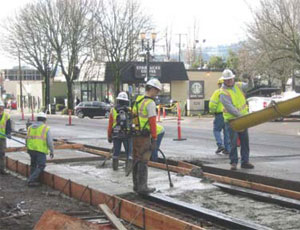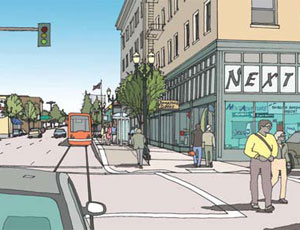...the three-week segment. The final week involves final grind and paving to tie in the existing roadway surface. Additional work includes curbs and gutters plus platforms for any of the 28 new stops for the loop.


Stacy and Witbeck worked on the previous phases of Portland Streetcar, the first of which opened in 2001 with a 2.4-mi line. Three other expansions added another 1.6 mi. Many lessons were carried over from the previous phases, allowing construction to move along faster.
“Our contractor is always keeping in contact with people on the street whenever they are going to impact a driveway for a short amount of time, coordinating that closure with the business,” Dannen says. “We make sure we keep the sidewalks open and driveways accessible. When businesses have deliveries, we make sure they can get those into their stores. People also appreciate knowing there’s someone to call if they have an issue.”
The team uses a multimedia approach to keeping its constituents informed, from a web page to meetings, regular emails, media outreach and social media sites such as Twitter and Facebook.
An impending hurdle for construction will be the bridge crossings. The north alignment for the loop carries the streetcar over the existing Broadway Bridge, which was recently retrofitted under a separate contract to support the streetcar. However, since the span is a double-leaf bascule bridge using massive counterweights to raise the bridge for river traffic, the challenge will be in the connections and constructing the rail on an active bridge. While vehicular traffic will be diverted for 60 days, the bridge still needs to continually raise and lower for barges and other vital river transportation traffic.
“To get the trackwork on the moveable span is challenging because you’ve got the toe joints where the two pieces come together and the heel joints where it pivots,” Wood says. “And then a year later we are going to be putting in the overhead catenary system, which is really tricky because you have to be able to make that dead when the bridge opens and keep people from touching any wires.”
The hard wiring will come up on either side of the bridge to be tied into the moveable span, requiring hinge connections and special electrically powered motors to move it back and forth because bridges naturally expand and contract throughout the changing seasons. On top of that, wind loads must be taken into account as the bridge is raised, so that the catenary wires and rails line up properly when the bridge comes back together, Wood says.
The southernmost crossing will be aligned over a future bridge being built for Portland’s other rail transport system, TriMet Light Rail, under a separate contract.
The existing Portland Streetcar line currently sees 12,000 riders a day, but Dannen expects this to increase once the new loop is in service. The city sees other benefits to the streetcar besides just taking cars off the roadways. “We’ve had extreme success with developers around the streetcar line, with $3.5 billion in development since 1997 within 2 to 3 blocks of the streetcar alignment,” she says.
Key Players
Owner: Portland Streetcar Inc.
Design Firm: URS
Owner’s Rep.: Shiels Obletz Johnsen, Inc.
CM/GC: Stacy and Witbeck, Inc.
Subcontractors: Nutter Corp.; Werbin West Contracting; Tice Electric Co.; Mowat Construction Co.; Hamilton Construction; Elcon Corp.
Useful Sources
Visit the project’s web site at
www.portlandstreetcar.org




Post a comment to this article
Report Abusive Comment